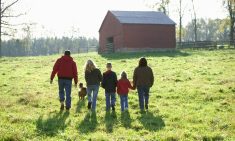Neighbourliness is stitched into the fabric of rural Canada. It always has been. In fact, as Dr. Catharine Wilson, professor of history at the University of Guelph might put it, “reciprocal labour” is what paved the way for our farming success.
“I don’t think we can overstate how important neighbours were,” says Wilson. It isn’t just rose-tinted glasses. Wilson’s findings are backed up with her analysis of 200 farm diaries written between 1800 and 1960 that are housed in her university’s Rural Diary Archive. (Many of these diaries are now available in searchable format online.)
We may think mainly of barn-raising, but it was many hands and strong backs that made every kind of progress possible: clearing the land, building houses and accomplishing other feats only possible with co-operative labour.
Read Also

Farmland values: assumptions and realities
Where farmland values are headed and what decisions farmers should make
We tend to think early settlers were very isolated, but Wilson says the reality is that hardly a day passed when a member of the farm family wasn’t helping a neighbour or being helped by a neighbour. This might involve hauling out a dead cow or chopping wood. Older women in the neighbourhood delivered babies and it was often neighbour women who helped prepare the bodies of the dead for burial.
Many of the services that are provided by the government or businesses today were once provided by neighbours, adds Wilson. Neighbours even got together to string the lines for the first telephones.
Wilson emphasizes that although work bees are often romanticized, reciprocal labour was not completely altruistic. It was a way to accomplish tasks that couldn’t be done on one’s own, she says.
It was also a surprisingly complex arrangement. People needed to be able to work through conflicts and there had to be flexibility around the repayment of labour as different people brought different tools and skill sets to a job, says Wilson. “People got to know who was best at sawing wood or who had the pot for boiling pigs.”
In general, co-operative labour worked because farms in a neighbourhood were producing similar crops and livestock using the same sort of equipment and methods, says Wilson. As Canadian farms became increasingly specialized, capitalized and monetized beginning in the 1960s, reciprocal labour dwindled, she says, although neighbourliness did not disappear altogether.
That was then
According to Statistics Canada, the farm population shrunk by almost two-thirds between 1971 and 2016. In 1931, the high-water mark for the Canadian farm population, one in three Canadians was a member of the farm population but by 2016 that number had tapered off to one in 58.
University of Guelph professor in rural planning Wayne Caldwell describes some of the impacts of the declining farm population on rural communities. As cars got better, it got easier and more convenient to travel farther to shop so many of the small local businesses closed. Likewise, many rural and small-town churches have closed. And with fewer children in rural areas, farm kids are bused many miles to school.
Caldwell says the loss of churches, schools and businesses can leave behind a diminished sense of community. And with farmers representing an ever-smaller proportion of the population, fewer farm voices are heard around the council table. “In earlier times, municipal councils were dominated by farmers,” he says “Today there may only be one or two farmers.”
However, while the word “community’” used to only mean those in close physical proximity, Caldwell points out that there are also other kinds of communities such as those created through social media or other communication technologies such as Zoom.
A typical family story
Today, a generation of farmers like Ken and Marie McNabb, both in their 60s, have fond memories of close-knit neighbourhoods with regular get-togethers. Neighbourliness defined their lives.
When he was young, Ken knew all the neighbours in his piece of Ontario. Most of them went to the same church so he saw them every Sunday, and they visited on a more or less constant basis.
With three boys in hockey and 4-H, Marie says the McNabbs naturally got to know a wider circle of other parents who had kids the same age as their sons rather than the immediate neighbours.
However, the McNabbs did connect with a small group of dairy farmers in their area with whom they share labour and equipment for spreading manure, haying and harvest.
Today, two of the McNabb’s sons, who are in their 20s, are beginning the process of farm transition with their parents. Marie says the younger generation “works with more technology which allows them more personal time than we had.”
The younger McNabbs are in touch with other young farmers in the neighbourhood via What’s App on a regular basis. This has led to a shared labour arrangement helping each other cover their bunk silos which has made the job much easier and faster. You also get to have a social visit afterwards, says Ken.
Both Ken and Marie, who attended the University of Guelph, have contacts across Ontario but one of their sons attended Olds College in Alberta and stays in touch with his contacts across Western Canada. “It has evolved. It’s gotten bigger,” says Ken.
And while being able to solve problems on your own is still important in farming, Marie says the next generation isn’t afraid to use their networks to call in help.
Jackie Dudgeon operates a beef farm near MacGregor, Man., with her husband Devon MacDonald. Both are in their early 30s. Dudgeon says there is a strong sense of community in their neighbourhood which is MacDonald’s home turf. If they need help, she says there are a number of neighbours they could count on and vice versa.
They are on the move, relocating to Dudgeon’s home area near Morden, where her dad has had a grain farm for many years. She sees a strong sense of community in this neighbourhood too. One of the things that still brings the neighbours together is a Harvest for Kids fundraiser. At the end of the season there’s a big meal in the field.
However, in her travels as the eastern Manitoba manager for a seed company, Dudgeon gets the impression that this strong sense of connection doesn’t exist everywhere. Climbing land prices and the competition for land is creating a sense of competition rather than co-operation, she says.
Dudgeon thinks it’s possible her generation is also less neighbourly. She has a few theories about this and thinks social media may play a role. With people posting only their favourable photos to social media, farmers can feel the pressure of keeping up with the Joneses to buy that shiny new tractor or combine. It can give people the impression they aren’t doing as well as the neighbours, she says.
And while seeing your neighbour’s posts on social media can give the impression that you know what’s going on in their lives, Dudgeon says this is a superficial level of connection and not a replacement for in-person visits.
Another explanation could be that young farmers have less time available to help others than in past generations. Dudgeon and MacDonald are both involved in the farm and both have off-farm jobs which they juggle with raising their family.
“We’re exhausted,” says Dudgeon, adding that perhaps younger farmers are more aware of the importance of mental health and if they get a little bit of time to themselves, they spend it on self-care.
While years ago, it was a custom for farm women to prepare meals for a sick neighbour, Dudgeon says she’d be more inclined to give the family a gift card or order a meal for them. Dudgeon also remembers her mom sending elaborate meals like lasagna, salad and garlic toast to the field but all she has time for is a rotisserie chicken.
But there are bright spots too. Although younger generations may not be as close with farmers in their neighbourhood, Dudgeon has connected with an informal group of like-minded farmers from across Canada that she met while attending a Canadian Young Farmers Forum conference in P.E.I.
More than two years after the conference, the group is still communicating on a regular basis, says Dudgeon. “We’ve learned so much from each other.”
Reconnecting in rural Canada
Dr. Jody Carrington, psychologist, author and public speaker, from Olds, Alta., is concerned about the impact of the stress of the global pandemic on mental health, disconnection and divisiveness in rural Canada.
When we get overwhelmed, we get irritable and less tolerant and we lose our capacity for empathy, kindness and compassion, Carrington says.
Speaking via a Farm Credit Canada webinar recently, Carrington had some simple suggestions to help restore the sense of connection in rural communities.
Imagine the next time you’re driving down your road, you pull up to a stop sign and see a neighbour, Carrington wants you to give them a really big wave which will get noticed. Other small actions that let others know they matter include buying a coffee for the person in line behind you and making eye contact at the hockey rink.
“Relationship and connection. We know how to do this in agriculture,” says Carrington. “It’s up to you and me, to do the next best right kind thing.
Proportion of medium-sized farms shrinks
Guelph ag economist Al Mussell has raised a red flag about the impacts of ongoing economic-demographic trends in Canadian agriculture on municipal governance, rural organizations and supports for farmers.
Mussell’s analysis, using Farm Cash Receipts (FCR) to sort farms by size, shows there has been a steep decline in the middle-sized farms and their share of FCR. Demographic trends also show “a declining (but still large) number of small farms, for whom agriculture is not the primary source of household income” and “a much smaller number of large and very large farms that are growing in number, for whom agriculture is the overwhelming source of household income, that are the dominant source of FCR.”
In his report, Mussell writes, “These observations are consistent with a collapsing middle of the economic distribution of farms, and threaten the community constituted by agriculture, with its commonality of interests, views and institutions developed to support them.”
He calls on governments and industry to engage in “a renewal of institution building that can help to address the trend of stratification of farms, preserve a diverse community in agriculture, and in so doing, address the related issues requiring collective action.”
















